- How to Grow a SaaS (Software) Business FAST - February 10, 2025
- 6 Advanced SEO Tips to Dominate the Search Rankings in 2025: Informed by Our Biggest Clients - January 17, 2025
- 7 Advanced Tips for Companies Spending $1M+ on Google Ads - December 10, 2024
Blogs are a great way to express your take on anything. No matter how niche the subject, there’s probably an audience out there for your content.
But bloggers — in addition to all the warm fuzzies they get from writing — enjoy making money.
And you know what’s great? It only takes 6 months of blogging to make enough money to quit your day job. Seriously!
This blog, Growth Marketing Pro, gets 50,000+ visitors each month. And now we earn over $150,000 in net income per month.
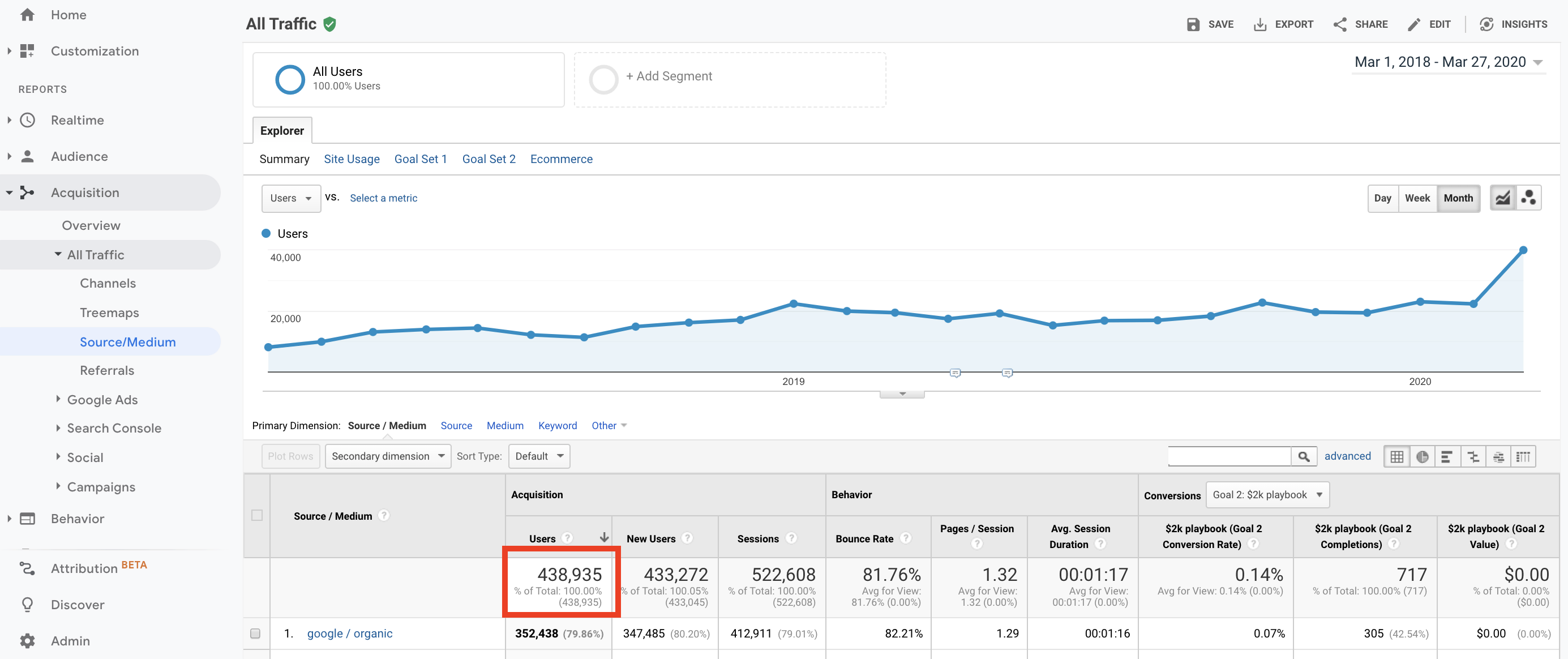
After I left my day job, I joined some friends on a blog called ManlyWellness. It’s a men’s mental and physical health site. I joined in February 2020 and two months later, we hit 117,000 organic visitors in a single month. It net us over $30k/month for a year before we sold ManlyWellness to a public company.
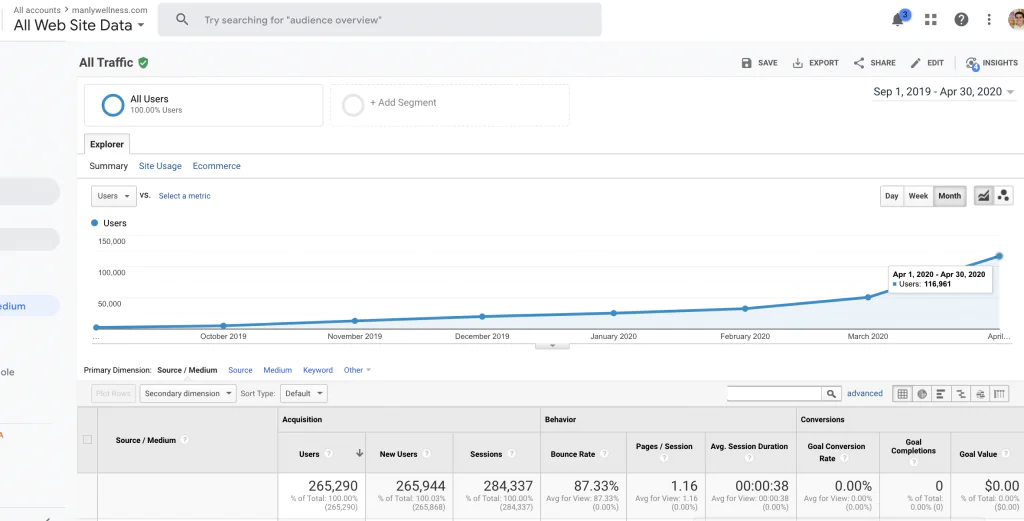
The point is this: you can make a good deal of money blogging in a pretty short amount of time. You just have to know how to:
- Get traffic to your blog (fast)
- Figure out how to monetize that traffic
You need to think like an entrepreneur.
I learned how to do that by leading marketing at San Francisco tech companies in the real estate and healthcare space. We made buckets of money by creating content and funneling our blog readers into the products we sold.
To do blogging right, you have to think like a CEO. You have to be intentional with your writing and you need to offer your visitors something of genuine value.
Long past are the days of “build it and they will come” — 5 years of writing to turn a small profit. Today, you can move fast by scaling your time and thinking strategically about your blog business.
But first, how should you choose what to even write about?
Also read: Learn to start your blog here.
Table of Contents
How to Choose a Blogging Niche to Make Money
According to ProBlogger Report, only 4% of bloggers make more than $10,000 a month.
One reason a lot of bloggers fail is that they choose a bad niche.
I recommend choosing something you know… preferably something you’re a subject matter expert in. So if you struggle to balance a checkbook or stick to a budget, you shouldn’t be a personal finance blogger. But if you ride fixed-gear bikes and tune up old beach cruisers, you could consider starting a cycling blog.
Every blogging niche can monetize. But it certainly helps to choose something that’s tried and true. Marketing and personal finance are two niches that happen to do quite well.
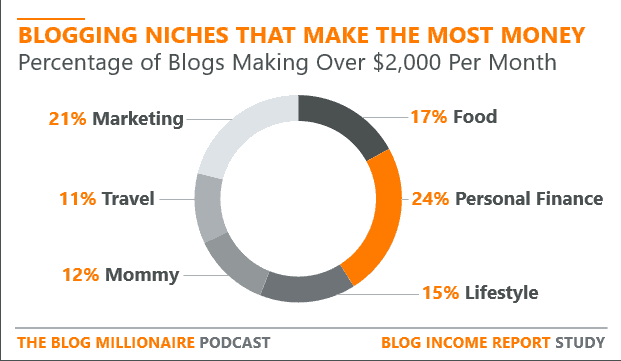
But really, you can choose to write about anything. As long as people are buying products online that are tangentially (or exactly) related to your niche, you can make money.
To illustrate: A cycling blogger could monetize via affiliate marketing, by selling popular gear from their favorite brands. A real estate blogger can sell an online course about how to make money in fix-and-flips. A tax blogger could sell his/her consulting time.
Pro tip: Whenever possible, choose a B2B niche. In other words, choose something that can be sold to businesses — who normally have larger budgets and are more willing to spend large sums.
Also read: The 12+ Most Lucrative Blogging Niches
There are a number of niches to choose from. My point is that you should be intentional when selecting.
Want my free 5-part SEO course?
My course has helped over 20,000 students master SEO with tips that aren’t in this guide or anywhere else on the internet!
Creating a Blog
If you haven’t even started your blog yet, it’s easy. I promise! Choose a blogging platform like WordPress.
WordPress, Contentful, Ghost, and other CMS blogs are optimal for attracting organic (search engine) visitors — users who simply stumble on your blog while Googling “the best way to fix a Volvo” or “how to monetize your blog?”
Unfortunately, other “instant site” platforms like Wix and Squarespace are not very SEO friendly. But if you start a WordPress blog, you’re in great shape.
The look of your blog can play a huge role in keeping people on-page and bringing people back to it. When it comes to design, the first thing you want to do is make the content easily scannable. It should be organized and relatively self-explanatory.
Tips for designing your blog:
- Match the color theme of your blog with the mood of the content.
- Keep the contrasts such that the text is easy to read.
- Ask yourself, “if I landed on this website, would I ‘get it?’”
- Try to make your posts more clickable by adding pictures to them.
- Use social proof where possible — press badges, client logos, etc.
- Use tables of contents in long posts so that users can skim and scan.
- Ensure you have a main menu that enables users to get to any part of your site in under 3 clicks.
- Once you’ve proven the concept and have some traffic, install a few plugins like “lazy load” and a CDN to serve your images dynamically — both of these things will make your site faster and more responsive for your readership.
Getting Traffic to Your Blog in 3 Steps
Now that you have a niche, you need to write content. I recommend 3 articles per week for the first 6 months. This velocity of content is enough to get you on Google’s map, earn some domain authority, and generate enough traffic to make sales. All of that ladders up to a good SEO strategy.
But the hardest part is getting started.
These are the most important 3 parts of SEO — which should be more than enough to get you to your first $10,000 per month!
FYI: We created a tool called GrowthBar. It helps you make and optimize blog content with one click of a button.
1. Keyword Research
The biggest mistake many bloggers make in the beginning is writing about everything. Being scattershot is okay every now and again — sometimes those posts are the most fun and fulfilling to write — but it’s best to be targeted. This means doing keyword research.
Not all keywords are created equal. The surest way to succeed in growing traffic and monetizing your blog is to find keywords that are highly searched, but uncompetitive.
There’s no reason to waste your time writing tons of great content on a topic that’s never searched! And it would be equally dumb to try and rank for “Walmart” or “Michael Jordan memorabilia.”
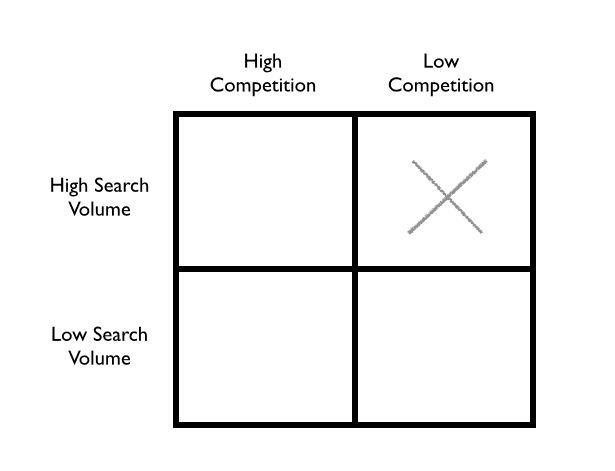
Pockets of SEO arbitrage exist all over the internet. In order to figure out which keywords to write about, use a tool like the one we built — GrowthBar — to judge the competitiveness and search volume of a keyword. Other tools like Semrush and Moz also do this, at a much higher price point.
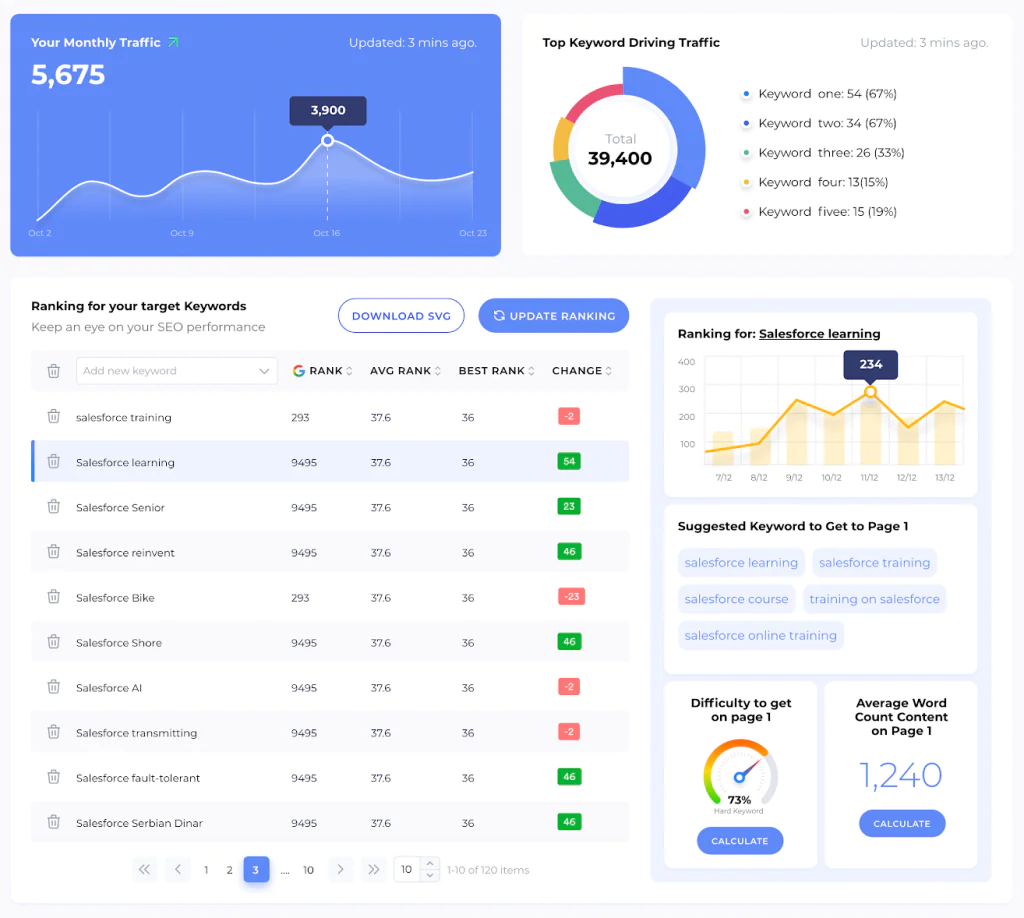
If you don’t want to invest in a tool, you can try Google’s Keyword Planner — a free tool that comes with a Google Ads account. You can also use your best judgment when deciding on keywords. Google it and see what pops up. If page 1 is full of huge companies or sites that haven’t been updated since 2002, you may not on the right track.
Be creative: when I started working on ManlyWellness with my friends, we decided erectile dysfunction medication online search volume would continue to grow (lol). We picked a great topic to write about — search volume is relatively high, and since the industry is nascent, competition is low. Plus, I only expect interest in the sector to explode over time, particularly post-COVID.
If you need a keyword research and 5 star rated SEO tool, try GrowthBar for free.
2. Only Publish Quality Content
A good barometer should be, “would I read and genuinely enjoy this post?” If you don’t like your own writing, how could some other internet peruser? If you’re going to be a thought leader in your niche space, you better be a really, really quality one. You need to write comprehensive, optimized blog posts.
Almost always, I see a correlation between how much time I spend on a post and the amount of traffic the post gets. If you want Google to rank your content in Google searches, it must be best-in-class.
The Google algorithm is very sophisticated. It knows good content from bad.
But you should make your life easy. Once you get the hang of writing and posting quality stuff, find writers to outsource to or use a tool to speed up your writing. Upwork and TextBroker both have quality ghostwriters at relatively inexpensive prices. It’s always best for you to do keyword research and write a brief outline, but nothing scales your blog work like great writing help.
Or, if you want to keep writing in-house, check out an AI writing tool like GrowthBar to make your content come to life way faster.
3. Get Backlinks and Distribution
Backlinks are hyperlinks from someone else’s website to yours. And they’re a necessary part of any good search engine optimization strategy.
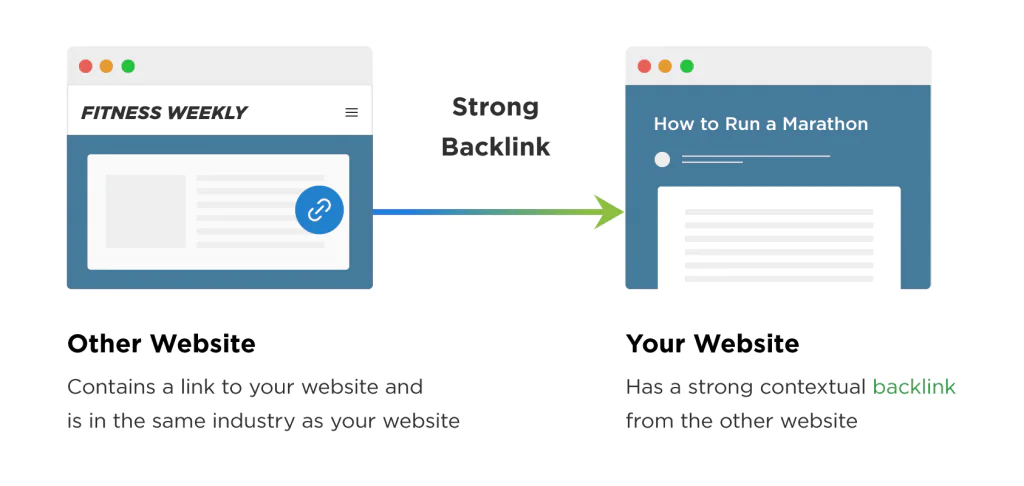
The more backlinks you have from high Domain Authority (reputable) sites, the more Google will consider your website an authoritative source of information.
If you want to rank for your target keywords, you must have links from authoritative sites to your domain (it’s even better if the backlinks are to the specific page you want to rank).
The best strategies for getting backlinks include:
- Guest posting: Guest blogging is one of the perfect ways to get people’s attention to your blog. Guest blogging means you write a blog post and give it to some reputable, well-known blog to host it.
- PR: If you can generate natural press because of your unique story, you should definitely pursue it. Put out press releases, tell industry publications, and get cozy with reporters in your niche. PR is a great way to generate backlinks.
- Reports, infographics, and data: If you’re a thought leader in your space or you have unique information that no one else has, turn it into a report or make a simple infographic. Put them out on social media and send them to “friendlies” in your industry. Google will index your work and bloggers will inevitably pick them up and include them in their posts.
- Backlink exchange: While this is technically considered bad practice by Google, you can still get away with swapping relevant links with peers in your niche where they make sense.
- Sniping your competitors’ backlinks: See who’s linking to your competitors and get them to replace those links with yours! Or, if you’re feeling nice, just ask them to write about you too!
Read: The 25 Best Ways to Get Backlinks here or 10+ SEO Growth Hacks.
Sign up for my free SEO email series by clicking below.
Want my free 5-part SEO course?
My course has helped over 20,000 students master SEO with tips that aren’t in this guide or anywhere else on the internet!
The Many Ways to Monetize Your Blog
Once you have traffic coming to your blog, you need to figure out how to monetize it. There is an art and a science to that process.
The most important thing to remember is to MVP test everything you can. MVP stands for minimum viable product. This means you want to get the highest output from the lowest input.
Let’s face it, your time is super valuable as an entrepreneur-blogger. Don’t spend 4 months creating a course only to realize that your audience doesn’t want it!
Instead, build a shell of a course and put it on sale on your site. If people start buying it, great! Tell them you accidentally put it up there and refund them immediately. If you feel bad about it, send them a $25 Amazon gift card for their trouble (that’s what we’ve done).
The point is to “fail fast.”
1. Monetization through Consultancy
You’ve probably seen a law blog or financial advisor website that looks flat-out ugly. But they may very well still make some good money! That’s because they can charge a lot for their services. Lawyers charge up to $400+ an hour. So it’s not terribly difficult for them to get to $10k/month.
In the early days of a blog, when traffic is rather low, the best way to monetize is via consulting. That’s because you don’t need a lot of traffic to make a few thousand bucks. Particularly if your site traffic is very niche and specific to a high-value industry, there are likely a few readers willing to pay for your services.
So how should you make consulting happen?
- Usually, it starts with turning your traffic into email subscribers. Use a tool like Leadpages to create a popup with a compelling offer — a free download, video, or email series. Provide something with real, tangible value — something actionable that your audience can implement.
- What follows is an email nurture series. Use a tool like ConvertKit to create a custom email set. Your email should have 5+ emails over the course of a week or two. Be vulnerable and tell a story to your audience. Your audience will continue opening your emails if they’re entertained!
- Once you’ve shown value and thought leadership, give your audience a chance to book a call with you. Use a tool like Calendly or a Calendly alternative to enable them to schedule in just a couple clicks.
Read: The 10 Best Ways to Capture Email Leads
2. Monetize Your Blog by Selling Other People’s Stuff: Affiliate Marketing
This has proven to be the most popular and one of the most lucrative ways of monetizing a blog.
You can earn a few hundred dollars a year, or in the case of a large affiliate marketing company like NerdWallet — which sells leads to credit card companies — over $100 million.
If you’re monetizing your blog with affiliate marketing, you promote certain products or services of a company in exchange for part of each of that company’s sales.
If you’ve ever bought a plane ticket on Expedia or Kayak.com, you’ve transacted with an affiliate. Expedia and Kayak certainly don’t fly your plane, but they do sell you the ticket. They take a cut of every sale.
Affiliate marketing works for a lot of blogger verticals:
- Fashion bloggers who sell shoes or bags to their readership with affiliate partnerships in place
- Tech bloggers who get a cut of every gadget their audience buys through their links
- Industry bloggers who promote trusted software tools
- Finance bloggers who recommend certain credit cards or investment options
The affiliate marketing universe is huge. There are literally thousands of companies that are affiliates of other goods and services.
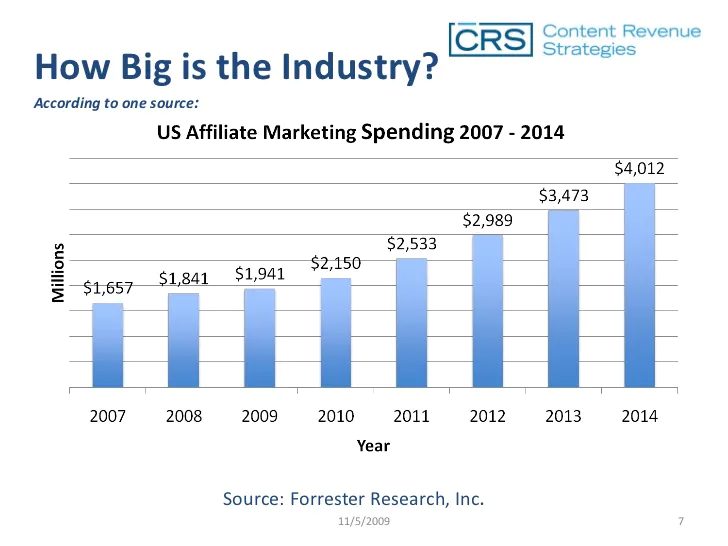
Usually, affiliate marketing is the next place people look to monetize their blog after consulting. You need a few thousand visitors a month to make affiliate marketing work. Standard ecommerce conversion rates are between 1-3% (but vary significantly). So with just a couple hundred visitors, you won’t be making much money.
How to become an affiliate partner: there are a few ways…
- Reach out to the companies in your niche and build a one-off partnership
- Many companies will have a link somewhere on their site to an affiliate page where you can sign up
- Sign up for sites like Commission Junction and browse through all the products you can sell
- Sign up for Amazon Associates and sell any Amazon product and earn a 4%-10% commission on every sale
Read: How to Do Affiliate Marketing Right
3. Monetize Your Blog by Selling Online Courses
Selling online courses is one of the most popular ways for bloggers to make money. You can generate income on autopilot with courses. Just make sure you’re niche enough that your readers can’t get your information through a simple Google search. And make sure you know what you’re talking about!
But if you know some things your audience is willing to pay for, use a tool like Teachable or Udemy to create and sell your course.
See our post: The 8 Best Online Course Platforms to learn more.
The idea here is to know your audience and create a course that addresses their particular needs. People will pay for good advice online!
Unfortunately, most courses online sell for only $100 to $500. The numbers don’t work in your favor, and it’s actually quite difficult to make $10,000/month with courses unless you have a lot of traffic.
To do it, I’d recommend first surveying your audience to understand if your course is something they’d be interested in. If you think you’ve hit a vein, make an MVP of your course — build a skeleton and see if people will pay for it.
Nothing is worse than spending time and resources on something you can’t sell. That takes time away from building your blog and testing other methods of monetization. Don’t do it!
4. Monetize with Ebooks
As with selling online courses, you have to write what you’re most passionate and knowledgeable about. You should make it graphically pleasing — maybe consider creating some infographics in Piktochart?
An Ebook is a tell-all guide that helps a reader learn a new skill. To properly sell an Ebook, you need to pitch it with data. Nobody will spend money on a piece of digital paper if it doesn’t help them learn a really valuable skill or better yet… make money.
If you go this route, use a catchy title for your Ebook like, “Learn How to Make $425k Per Year Flipping Houses.” People like specifics.
Unfortunately, the most anyone can charge for an Ebook is $200. So again, you’ll need a lot of traffic to make it work.
We sell an Ebook on Growth Marketing Pro and make about $500/month with it. It’s a $49 webinar script. And it’s actually very good. But still, without tons of traffic, it’s a drop in the bucket.
5. Monetize Your Blog with Google Ads
Google Adsense is critical to many monetization strategies. All the big blogs like Healthline, WebMD, BuzzFeed, and Huffington Post monetize with ads — to some degree.
You can make good money running ads on your blog, however, you should know that you will need a lot of traffic to make Adsense really pay.
When you’re monetizing your blog using Adsense, you are basically selling billboard space on your website.
In order to run Google Adsense, you’ll need to install a small script that you can copy and paste into your blog’s code to decide where the ad will appear. If you’re using WordPress, there are easy plugins to make this happen.
You don’t have too much control over what ads appear on your blog. In fact, these ads are mostly synchronized with what the customer has been searching for on the internet (cookies attached to the user’s browser for remarketing campaigns).
However, the important thing to note is that while display advertising sounds like the sexiest, most passive income, it’s difficult to make work with fewer than 5,000 visitors a day on your blog.
Therefore, display advertising is most suitable for blogs that get a lot of traffic on a daily basis. Even so, I tried running Google Adsense on ManlyWellness — which again, gets 100k+ monthly visitors — and still was only making a few bucks a day.
Google Adsense is CPC — which means cost-per-click. As the name implies, you get paid for every click on a banner ad on your website. So as your users browse your blog and click ads, you make money.
Usually, you can get about 30 cents per click. Users generally click less than 1% of the time on your site. So the earnings numbers aren’t very compelling.
There are newer platforms like AdThrive that pay premium rates for certain content verticals. It’s worth a look if you have 100k+ in organic traffic.
6. Monetize Your Blog through Sponsorships
In the sponsorship model, bloggers charge larger partners for various things, including:
- A sponsored product/service review: you write a review of your experience with a product to share it with your audience
- A banner ad: a dedicated banner for a partner (similar to Adsense, but you pick what goes there, not Google)
- Guest blog post: the partner writes a blog post to live on your blog
- Dedicated email blast: if you have an email following from your blog, you can use it to monetize your blog by advertising a product you love
As with affiliates, it’s on the blogger to find relationships with partners in the industry. You will need to prove to them that your blog is worth partnering with.
This is where the authority, reputation, and visitor count of your blog matters.
The more visitors come to your blog on a daily basis and the more engaged they are, the more the advertiser will be interested in buying some of your blog’s real estate or mindshare.
Often, the blogger will reach out to the partner or vice versa. Partnerships can often be mutually beneficial — so they’re easy to strike with the right partner.
7. Monetize Your Talents by Writing for Other Platforms
You can harness your talent as a content creator by creating content for other platforms. While this isn’t exactly monetizing your blog, it’s using the credibility you have built in the space and charge for guest posting.
Your blog is the place where you show the power of your writing and thought leadership. If you’re able to attract a committed enough following, you may be able to parlay that into writing work. If you’re blogging to get hired as a staff writer, do a few things:
- Create a website in addition to the blog to put forth your best write-ups. Market yourself.
- Put only quality content on your blog. Pick a niche that you are most passionate about and write within that niche to get noticed.
- Visit popular blogs and comment on them. Try to keep your comments as natural as possible rather than sticking out as promoting yourself and your blog.
- Check online job boards where you will see dozens of companies looking for people to write for their blogs. Sometimes, they will pay you hourly and sometimes per blog post. Pick your payment method wisely.
- Visit famous blogs that are related to your niche and look for the “hire me” tab. Sometimes, you might not see this tab on the blogs, but you can always use the contact information or online form to get in touch with the blog author.
- Take a lesson from the point above and include a “hire me” tab on your blog as well, so people who visit your blog know that you are available for writing.
But Avoid Making These Mistakes
Blogging isn’t easy. If you’re going to embark on monetization of your blog don’t make these mistakes:
- Don’t expect any overnight and quick returns. It can take up to a year before you see any significant response from your visitors. Be patient! Remember, this is going to take about 6 months.
- Don’t write an ebook or start selling one-on-one sessions right from day one—it will be a huge failure. You don’t even know what content your audience wants to pay for yet!
- Don’t just keep on uploading posts. Interaction with your blog visitors is extremely important to position your blog and personal brand in the beginning.
- If you’re an affiliate, don’t hide that some of your posts earn you income. Put a disclaimer of some sort, somewhere, for the sake of transparency with your readership. Google will appreciate that too. Google has explicitly said this is necessary if you’re going to sell via affiliates. They’ll reward you with higher rankings if you do.
- Don’t put your faith in Google Adsense. Again, you need a lot of traffic to make any money from Google Ads. You need to be more creative than that!
- Don’t forget backlinking. Your site simply will not appear in Google searches unless you have some authoritative backlinks to your blog. Writing content is only part of the battle. Getting distribution for your content is equally important.
Need a keyword research and 5-star rated SEO tool? Try GrowthBar free…
Final Words
Do not forget that your blog readers will give you their money only when you offer them some value. Create great content and get readers… then figure out how to monetize your blog.
Want to learn more about blogging for SEO and making money blogging? Explore these articles:
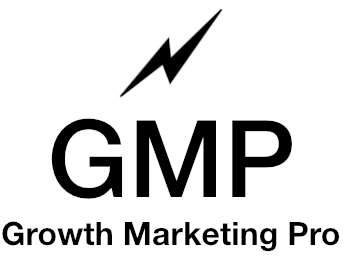


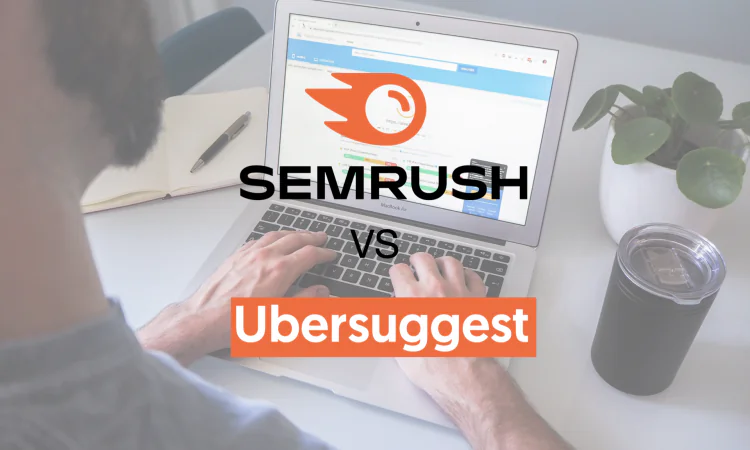

Amazing stuff. As a new blogger got a great knowledge on this. thanks for sharing.
This is so needed and extremely helpful. THANK YOU, you’re awesome!
I could not resist commenting. Perfectly ѡritten!
Targeting B2B market is a new concept to me – very interesting. I started my blog about 2 years ago as a place to showcase my hobby projects – antique needlework techniques. Some of the tutorials have accumulated 400+ backlinks over this time. I haven’t done any PR, maybe will now. I have submitted the tutorial to a dozen sites that accept DIY projects – this helped to get the initial traffic. Ad Sense somehow never made any financial sense – I get about $6 a month and it’s impossible to track their CPM rate to even understand why the pay is so low. About a year ago I tried Codec sponsored content plugin from WordPress as well – read about it somewhere on a content monetizing forum. This plugin pays about $2.8 CPM so I get $120 a month for 9K-11K unique visitors a month. Not a lot of money, but I only post 1 tutorial a month. It takes me about 2 hours to make the tutorial, so I feel like it’s a good rate of $60/hour to do something you genuinely enjoy.
Keep up the wonderful work, I read few blog posts on this website and I believe that your blog is real interesting and holds lots of good information.
Awesome article as it gets me thinking about the various ways to monetize my site. Thank you so much for your excellent and relevant article
Wonderful blog post, thanks for sharing with us
Thanks a lot. The way you explain about any topic in your article and the way you explain and share information, hardly anyone can explain it. Therefore I like your articles very much
Hi Mark, thanks for the detailed article about blog monetization. But I need to know one thing. Can you tell me except Amazon which is the best affiliate marketing network I can use? Because Amazon has reduced the commission rate. And I as a new blogger won’t have much traffic. SO a good rate of commission will earn me something.